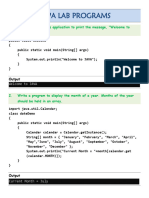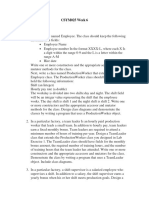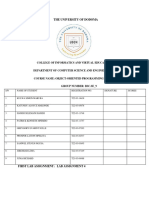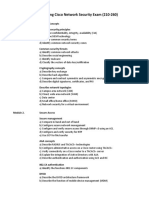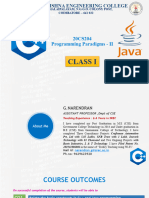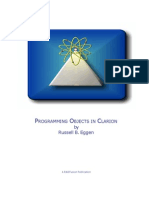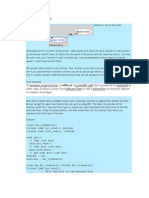0 ratings0% found this document useful (0 votes)
1K viewsJava Assignment-2
1. Write a Java program with the following classes - Invoice, OrderItem, Order, and RushOrder - based on the UML diagram.
2. The Invoice class should track part details and calculate invoice amounts. OrderItem stores item details and costs.
3. Order contains a list of OrderItems and methods to add items, get total cost, and print items. RushOrder extends Order by adding a delivery day and overriding getTotal() to include delivery fees.
Uploaded by
Mangesh AbnaveCopyright
© © All Rights Reserved
We take content rights seriously. If you suspect this is your content, claim it here.
Available Formats
Download as DOCX, PDF, TXT or read online on Scribd
0 ratings0% found this document useful (0 votes)
1K viewsJava Assignment-2
1. Write a Java program with the following classes - Invoice, OrderItem, Order, and RushOrder - based on the UML diagram.
2. The Invoice class should track part details and calculate invoice amounts. OrderItem stores item details and costs.
3. Order contains a list of OrderItems and methods to add items, get total cost, and print items. RushOrder extends Order by adding a delivery day and overriding getTotal() to include delivery fees.
Uploaded by
Mangesh AbnaveCopyright
© © All Rights Reserved
We take content rights seriously. If you suspect this is your content, claim it here.
Available Formats
Download as DOCX, PDF, TXT or read online on Scribd
You are on page 1/ 4
Java Assignment-2
1. Write a method called isAllEven that takes an array of integers
as a parameter and that returns whether or not all of the
values are even numbers (true for yes, false for no).
2. 1.Create a class with a method that prints "This is parent
class" and its subclass with another method that prints "This
is child class". Now, create an object for each of the class and
call
1 - method of parent class by object of parent class
2 - method of child class by object of child class
3 - method of parent class by object of child class
3. Create a class named 'Member' having the following
members:
Data members
1 - Name
2 - Age
3 - Phone number
4 - Address
5 - Salary
It also has a method named 'printSalary' which prints the
salary of the members.
Two classes 'Employee' and 'Manager' inherits the 'Member'
class. The 'Employee' and 'Manager' classes have data
members 'specialization' and 'department' respectively. Now,
assign name, age, phone number, address and salary to an
employee and a manager by making an object of both of
these classes and print the same.
4. Create a class named 'Rectangle' with two data members
'length' and 'breadth' and two methods to print the area and
perimeter of the rectangle respectively. Its constructor having
parameters for length and breadth is used to initialize length
and breadth of the rectangle. Let class 'Square' inherit the
'Rectangle' class with its constructor having a parameter for
its side (suppose s) calling the constructor of its parent class as
'super(s,s)'. Print the area and perimeter of a rectangle and a
square.
5. Create a class named 'Shape' with a method to print "This is
This is shape". Then create two other classes named
'Rectangle', 'Circle' inheriting the Shape class, both having a
method to print "This is rectangular shape" and "This is
circular shape" respectively. Create a subclass 'Square' of
'Rectangle' having a method to print "Square is a rectangle".
Now call the method of 'Shape' and 'Rectangle' class by the
object of 'Square' class.
6. Write a program by creating an 'Employee' class having the
following methods and print the final salary.
1 - 'getInfo()' which takes the salary, number of hours of work
per day of employee as parameter
2 - 'AddSal()' which adds $10 to salary of the employee if it is
less than $500.
3 - 'AddWork()' which adds $5 to salary of employee if the
number of hours of work per day is more than 6 hours.
7. Create a class called Invoice that a hardware store might use
to represent an invoice for an item sold at the store. An
Invoice should include four pieces of information as instance
variables‐a part number(type String),a part description(type
String),a quantity of the item being purchased (type int) and a
price per item (double). Your class should have a constructor
that initializes the four instance variables. Provide a set and a
get method for each instance variable. In addition, provide a
method named getInvoice Amount that calculates the invoice
amount (i.e., multiplies the quantity by the price per item),
then returns the amount as a double value. If the quantity is
not positive, it should be set to 0. If the price per item is not
positive, it should be set to 0.0. Write a test application
named InvoiceTest that demonstrates class Invoice’s
capabilities.
8. Consider the UML conceptual model shown below. You will be
writing class definitions for each of the concepts and
additionally for the test driver program following the
instructions below.
Add the class definitions of OrderItem, Order and RushOrder
classes in their separate .java files but all within the package.
Note that all of these classes are public.
OrderItem class has a String upc, an integer quantity and an
integer price, all private. The getCost() method returns the
multiplication of its quantity and price.
Order class has a list of OrderItem objects. The
addOrderItem() method takes an object of OrderItem as the
parameter and stores it in the list. The getTotal() method
returns the total cost of all order items in the order. The
printOrderItems() method prints information about each
order item via the toString() method of the OrderItem class.
RushOrder class extends the Order class. It has an integer
instance variable deliveryDay, a protected member, which
represents in how many days the order should be delivered.
The getTotal() method overrides the definition of the super
class in the following way: It first invokes the getTotal() of the
super class to find the total for all items in the order. It then
adds the delivery charge. The delivery charge for one day
delivery is $25, for two day delivery is $15, for three day
delivery is $10. It is free for four or more days. Note that, the
delivery charge should be added only if there are items in the
order. It means if the getTotal() of the super class returns 0,
do not add delivery charge, but just return 0.
You might also like
- Topic: Evolution of Java, Java Architecture, Language Basics, Flow Control25% (4)Topic: Evolution of Java, Java Architecture, Language Basics, Flow Control15 pages
- DSA - Lab - 02 - Implementation of Objects and ClassesNo ratings yetDSA - Lab - 02 - Implementation of Objects and Classes7 pages
- JAVA Assignment Part A - 20.3 UGC and 20.2 VUNo ratings yetJAVA Assignment Part A - 20.3 UGC and 20.2 VU4 pages
- Subject Code: 222CCS Subject Name: Object Oriented Programming in JAVA Assignment - 1No ratings yetSubject Code: 222CCS Subject Name: Object Oriented Programming in JAVA Assignment - 15 pages
- (PARUCHURI SUPRAJA) December23 (Java assignments)No ratings yet(PARUCHURI SUPRAJA) December23 (Java assignments)6 pages
- Assignment-2 1. Write A Java Program To Show That Private Member of A Super Class Cannot Be Accessed From DerivedclassesNo ratings yetAssignment-2 1. Write A Java Program To Show That Private Member of A Super Class Cannot Be Accessed From Derivedclasses19 pages
- 12th Inheritance Assignments Year Wise_24770473No ratings yet12th Inheritance Assignments Year Wise_2477047314 pages
- Java Programming Tutorial With Screen Shots & Many Code ExampleFrom EverandJava Programming Tutorial With Screen Shots & Many Code ExampleNo ratings yet
- Introduction To Nexus Repository ManagementNo ratings yetIntroduction To Nexus Repository Management1 page
- Oracle Database 12c R2 - Official ADMIN1No ratings yetOracle Database 12c R2 - Official ADMIN14 pages
- Selling Skills: Two Day(s) Training ProgrammeNo ratings yetSelling Skills: Two Day(s) Training Programme3 pages
- MCQ Tutorial - MCQ Questions For Set 31 in Cloud ComputingNo ratings yetMCQ Tutorial - MCQ Questions For Set 31 in Cloud Computing2 pages
- Cisco ASR 903 Essentials-Mapped With ASR920No ratings yetCisco ASR 903 Essentials-Mapped With ASR9201 page
- Implementing Cisco Network Security Exam (210-260) : Security Concepts Common Security PrinciplesNo ratings yetImplementing Cisco Network Security Exam (210-260) : Security Concepts Common Security Principles4 pages
- Cisco ASR 9000 HardwareOverview-Mapped With ASR9010No ratings yetCisco ASR 9000 HardwareOverview-Mapped With ASR90101 page
- Use Cases: Systems Analysis and Design in A Changing World 6 Ed Satzinger, Jackson & BurdNo ratings yetUse Cases: Systems Analysis and Design in A Changing World 6 Ed Satzinger, Jackson & Burd86 pages
- Object Oriented Programming Lab-09 (Multiple Inheritance)No ratings yetObject Oriented Programming Lab-09 (Multiple Inheritance)5 pages
- Object Oriented Programming and Java Second Edition Danny Poo - The ebook is ready for download with just one simple click100% (1)Object Oriented Programming and Java Second Edition Danny Poo - The ebook is ready for download with just one simple click47 pages
- Introduction To SAP and ABAP/4 LanguageNo ratings yetIntroduction To SAP and ABAP/4 Language11 pages
- JAVA: MCQ. These Are Sample MCQ Questions. Just For Practice. Option A/1 Option B/2 Option C/3 Option D/4 Answer100% (1)JAVA: MCQ. These Are Sample MCQ Questions. Just For Practice. Option A/1 Option B/2 Option C/3 Option D/4 Answer4 pages
- Van Der Post H. The Python For Finance Handbook... Financial Insights... 2024No ratings yetVan Der Post H. The Python For Finance Handbook... Financial Insights... 2024454 pages
- Based Binary Analysis Implementation Manual: Möbius Strip Reverse EngineeringNo ratings yetBased Binary Analysis Implementation Manual: Möbius Strip Reverse Engineering62 pages
- Download full Java: A Beginner's Guide: Create, Compile, and Run Java Programs Today Herbert Schildt ebook all chapters100% (3)Download full Java: A Beginner's Guide: Create, Compile, and Run Java Programs Today Herbert Schildt ebook all chapters50 pages
- AllPossibleQuestionBank (Desc&Obj) ..R22 OOPSJAVA 2324SEM1..14112023No ratings yetAllPossibleQuestionBank (Desc&Obj) ..R22 OOPSJAVA 2324SEM1..1411202318 pages

















